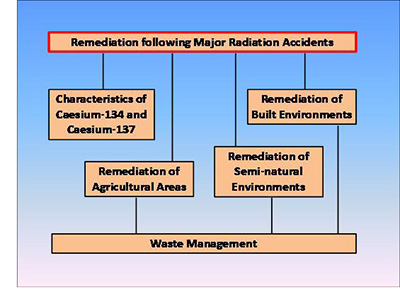
Background
Following Fukushima Dai-ichi accidents, contamination of the environment by iodine-131, caesium-134 and caesium-137 was of importance. Iodine-131 has a radioactive half life of only 8.02 days, so it is mainly of potential importance through ingestion of milk from animals grazing contaminated pastures. As it decays to negligible levels within a few weeks to months of the accident, it is not of major significance in remediation activities. In contrast, caesium-134 has a radioactive half life of 2.06 years and caesium-137 has a radioactive half life of 30.2 years, so both of these radionuclides can persist in the environment for an extended period. Thus, it is these two radionuclides are typically the focus of remediation activities.
The links provide information on the environmental and radiotoxicological characteristics of caesium-134 and caesium-137, and on approaches to remediation of different types of area. Attention is focused on examples of approaches being adopted following the Fukushima Dai-ichi accident.